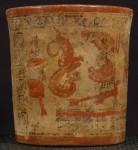 A multi-disciplinary team of archaeologists excavating in the El Palmar Archaeological Zone in southeast Campeche, Mexico has uncovered a stairway engraved with Maya hieroglyphic inscriptions. Out of the thousands of known Maya archaeological sites, only 20 of them are hieroglyphic stairways and of those 20 few have survived undamaged by looters, time or nature. These stairs were found still in their original positions and engraved with over 130 Maya glyphs.
A multi-disciplinary team of archaeologists excavating in the El Palmar Archaeological Zone in southeast Campeche, Mexico has uncovered a stairway engraved with Maya hieroglyphic inscriptions. Out of the thousands of known Maya archaeological sites, only 20 of them are hieroglyphic stairways and of those 20 few have survived undamaged by looters, time or nature. These stairs were found still in their original positions and engraved with over 130 Maya glyphs.
The staircase found on the El Palmar site is also unique because it was on the outskirts of the main center of the Maya city. The hieroglyphic stairways found before now have all been connected to the major monumental structures. That’s been part of the difficulty of finding original construction, because after the Classic Maya period (300 – 900 A.D.) there was a dramatic period of governmental and societal decline known as the “collapse” during which populations left the major centers and monumental construction ceased. When the cities were re-inhabited, people used the Classic structures for their stone and materials were recycled for reconstruction.
 The El Palmar staircase wasn’t in the main city and it escaped recycling. That makes the inscriptions easier to read as well as providing information about the original construction of the building itself. It still needed a lot of help from the archaeological team, however.
The El Palmar staircase wasn’t in the main city and it escaped recycling. That makes the inscriptions easier to read as well as providing information about the original construction of the building itself. It still needed a lot of help from the archaeological team, however.
The stairway was first discovered in 2009 when Gudiel Guzmán, a local worker attached to the fieldwork season of the joint team from the National Institute of Anthropology and History (INAH), the University of Arizona (UA) and the National Autonomous University of Mexico (UNAM), told Kenichiro Tsukamoto, a young archaeologist who was about to hit the big time while still a Ph.D. candidate at the University of Arizona, that he had found two carved stones while slashing and burning his property for agricultural purposes. Kenichiro and epigrapher Octavio Esparza went with Guzmán to see what he had found, and they realized that they weren’t just two stones, but part of a hieroglyphic stairway.
The stones were covered in dirt and had plants growing on them, but they were still close enough to the surface to make them a major looting target. The team changed their focus to salvaging and conserving the staircase, which they’ve been doing for the past two years. Now they’ve done enough work that they can announce their preliminary findings about the staircase and the inscriptions.
The pyramidal structure that holds the stairway was built between the 7th and 8th Centuries A.D. and a few decades after its construction a total of 90 blocks containing Maya glyphs were added, creating a stairway of six steps leading to a temple on top of the pyramid.
Octavio has partially deciphered the stairway inscriptions that commemorate an event dated probably to September 13, A.D. 726, and provide a list of successive El Palmar rulers. Of the most exciting finds was that the hieroglyphic stairway commemorated the visit of rulers from two major Classic Maya capitals: Calakmul and Copán. “Octavio’s decipherment suggests that Calakmul, Copán, and El Palmar were allies in the period just before Calakmul was defeated by Tikal [A.D. 736] and Copán by Quirigua” Kenichiro said in an interview.
 They also found a variety of intriguing artifacts in the main temple, some broken vessels on a burned plaster floor, and the burial of an adult male with jade inlays on his front teeth (Maya grill!) containing two polychrome vases. Team anthropologist Jessica Cerezo-Román will conduct further analysis on the human remains.
They also found a variety of intriguing artifacts in the main temple, some broken vessels on a burned plaster floor, and the burial of an adult male with jade inlays on his front teeth (Maya grill!) containing two polychrome vases. Team anthropologist Jessica Cerezo-Román will conduct further analysis on the human remains.
There is much work left to do. The hieroglyphic blocks will all be restored and analyzed for dating, geologists will examine the original geographic source of the obsidians used in construction, and biologists will study the soil and sediment and the burned plaster floor. This discovery will have a great deal to tell us about the late Classic Maya period.